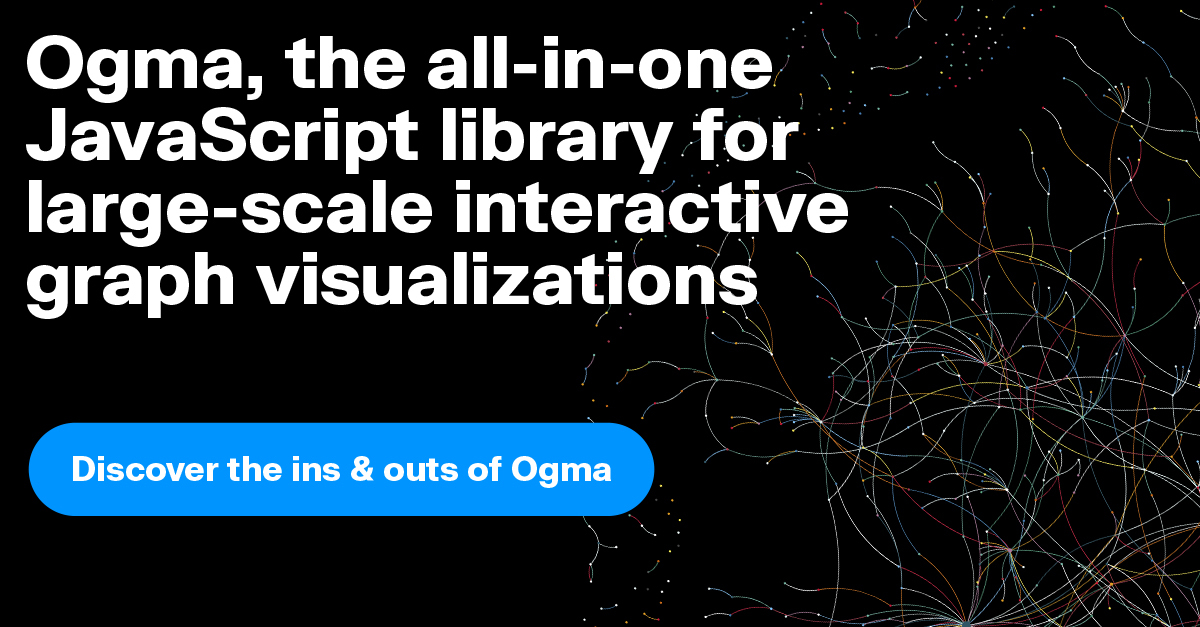Graph visualization, or network visualization, is a subcategory of data visualization that works specifically on graph data. It’s becoming more and more widely used as an increasing number of organizations see the value in graph analytics to gain deeper insights into their data and drive better business decisions. A JavaScript graph visualization library enables you to integrate graph visualization into your applications.
With a wide range of solutions available - from commercial to open source to specialized options - we've narrowed down the most popular JS graph visualization libraries for you. While other language libraries may pose challenges in integration, JavaScript is universally supported by web browsers, making it the ideal choice for building web applications. Get ready to elevate your data visualization game!
We’ve selected 13 of the most popular JavaScript graph visualization libraries. Below you’ll find essential information about each one, including information on integration, ability to handle large graphs, interactive features, and more. This list is broken down into three main categories: commercial libraries, general purpose libraries, and specialized open source libraries.
Commercial libraries offer the most extensive features and options, not to mention superior documentation and support. Because they come with a cost, they may not be well adapted for some projects.
This is a JavaScript / TypeScript library used for building interactive graphs and diagrams. It includes several built-in layouts and extensible tools, and is compatible with multiple frameworks including React, Angular, and Vue.js. GoJS only has Canvas and SVG rendering.
This JavaScript graph visualization library leverages WebGL rendering and is a powerful solution to develop large-scale interactive graph visualizations. It features many layout algorithms including a super fast GPU power layout, geo-mode, annotation layers, visual groupings, numerous styling options, and comes with many examples and templates. Ogma supports multiple integration frameworks for maximum flexibility.
Developed by yWorks, this library enables you to visualize any kind of graph, diagram, or network. It supports a wide range of desktop and web technologies, as well as many layout algorithms. yFiles also has a large features set and many extensibility options. There are several options to integrate yFiles with your application including Angular and React.
This graph visualization engine supports canvas and WebGL rendering. It supports many graph algorithms and offers many different layouts. Keylines easily integrates with existing web applications.
Cosmograph is a web-based application that helps users analyze large graph datasets and machine learning embeddings. It comes with components like timeline, histograph, and search. Cosmograph is the newest application on our list, so it is still to be proven.
General libraries can be adapted for many graph visualization use cases. These free libraries may be less powerful than their commercial counterparts, however, or lack integration options, requiring a bigger time investment.
The JS library is an especially popular one. It is used to manipulate documents based on data using HTML, SVG, and CSS. However, using it to build a graph visualization solution is highly time consuming. There is no set integration framework so you have to build one yourself and render all behaviors, requiring a large time investment.
This is a framework built on top of D3 used for creating interactive visualization designs. Specifications are written in JSON files instead of in JavaScript. Development of Vega.js is led by the University of Washington Interactive Data Lab, and the library is released under a BSD-3 license.
This browser-based library is under the MIT license. It works with large, dynamic datasets. Vis.js offers common customization options for styling nodes, labels, animations, and more. The layouts and algorithms are limited, however, and it’s difficult to customize the library beyond what is already offered.
This is a canvas-based graph visualization framework that integrates with React via its sister library Graphin. It’s well adapted for visualizing small to moderate sized graphs. G6 provides many algorithms and styling options. The implementations and API can be tricky, however, and parts of the documentation are in Chinese.
Open source libraries are available for anyone to use for free. Some may come with certain limitations or steep learning curves.
This JS library is developed and maintained by the Media Lab at Sciences Po, and has been released under the MIT license. Developers can use it to publish network and graph visualizations on web pages, as well as to integrate network exploration into web applications. Sigma.js can be integrated with React applications.
This is part of a collection of libraries, this one designed to support different rendering engines and layout algorithms. This JavaScript library has some customization options, but these aren’t comparable with those of a commercial graph visualization library.
This is a JS library for graph and network visualization, like Sigma.js. It is a non-profit library. There are no set integrations, so developers using this Cytoscape must build integrations on their own, which is time-consuming.
This is a network graph visualization library built in WebGL for React. It’s built on top of D3 and Three.js. Reagraph is high-performing but raw as a library.
Visualizing data helps us to better understand how processes works and how they connects with each other. JavaScript graph library solutions are a great way to visualize data as graphs in an intuitive manner. With the wide range of JavaScript graph libraries available on the market, developers have a great pool of readily accessible tools to visualize their data as a graph. Whether you're looking for commercial solutions, open source options, or more specialized libraries, you'll be sure to find what you need.
Our own JS graph library, Ogma, comes equipped with everything you need to easily visualize and analyze your graph data and increase your productivity across the board. Ogma leverages WebGL rendering, a modular architecture and state-of-the-art layout algorithms to make the visualization of large graphs not only possible, but powerful. Experience for yourself just how much this library can do for your project.
A spotlight on graph technology directly in your inbox.
